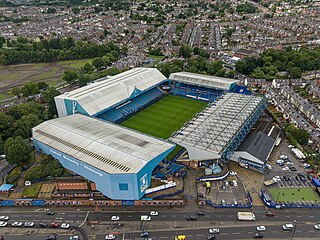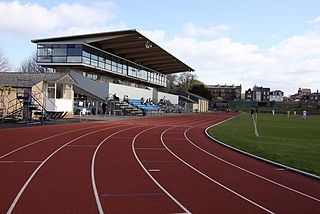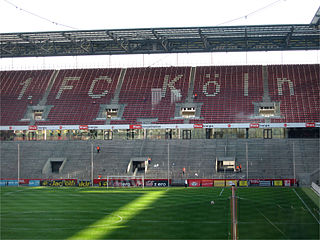
The Hillsborough disaster was a fatal crowd crush at a football match at Hillsborough Stadium in Sheffield, South Yorkshire, England, on 15 April 1989. It occurred during an FA Cup semi-final between Liverpool and Nottingham Forest in the two standing-only central pens within the Leppings Lane stand allocated to Liverpool supporters. Shortly before kick-off, police match commander David Duckenfield ordered exit gate C to be opened in an attempt to ease crowding, which led to an influx of supporters entering the pens. This resulted in overcrowding of those pens and the fatal crush; with a total of 97 fatalities and 766 injuries, the disaster is the deadliest in British sporting history. Ninety-four people died on the day; another person died in hospital days later, and another died in 1993. In July 2021, a coroner ruled that Andrew Devine, who died 32 years later, after suffering severe and irreversible brain damage on the day, was the 97th victim. The match was abandoned and restaged at Old Trafford in Manchester on 7 May 1989; Liverpool won and went on to win that season's FA Cup.

Hillsborough Stadium is a football stadium in Sheffield, England. It has been the home of Sheffield Wednesday since opening in 1899.
The Hillsborough Stadium Disaster Inquiry report is the report of an inquiry which was overseen by Lord Justice Taylor, into the causes of the Hillsborough disaster in Sheffield, South Yorkshire, England, on 15 April 1989, as a result of which, at the time of the report, 95 Liverpool fans had died. An interim report was published in August 1989, and the final report was published in January 1990.

The Bradford City stadium fire occurred during a Football League Third Division match on Saturday, 11 May 1985 at the Valley Parade stadium in Bradford, West Yorkshire, England, killing 56 spectators and injuring at least 265. The stadium was known for its antiquated design and facilities, which included the wooden roof of the main stand. Previous warnings had also been given about a major build-up of litter in the cavity below the seats in the stand. The stand had been officially condemned and was due to be replaced with a steel structure after the season ended.

The Sports Grounds Safety Authority (SGSA) is a non-departmental public body in the United Kingdom funded by the Department for Culture, Media and Sport (DCMS). Until 2011 it was known as the Football Licensing Authority, having been set up under the Football Spectators Act 1989. The SGSA was established through the Sports Grounds Safety Authority Act 2011, which received royal assent in July 2011 and commenced on 1 November 2011.
Simon Inglis is an author, editor, architectural historian and lecturer. He specialises in the history, heritage and architecture of sport and recreation. Inglis is best known for his work on football history and stadiums, and as editor of the Played in Britain series for English Heritage.
John Thomas Wheatley, Baron Wheatley, was a Scottish Labour politician and judge.

An all-seater stadium is a sports stadium in which every spectator has a seat. This is commonplace in professional association football stadiums in nations such as the United Kingdom, Spain, and the Netherlands. Most association football and American football stadiums in the United States and Canadian Football League stadiums in Canada are all-seaters, as are most baseball and track and field stadiums in those countries. A stadium that is not an all-seater has areas for attendees holding standing-room only tickets to stand and view the proceedings. Such standing areas are known as terraces in Britain. Stands with only terraces used to dominate the football attendance in the UK. For instance, the South Bank Stand behind the southern goal at Molineux Stadium, home of Wolverhampton Wanderers, had a maximum of 32,000 standing attenders, while the rest of the stadium hosted a little bit less than that; the total maximum attendance was around 59,000.

The Roger Bannister running track, also known as the Oxford University track, is a 400-metres athletics running track and stadium in Oxford, England. It was where Sir Roger Bannister broke the four-minute mile on 6 May 1954, when it was known as the Iffley Road track. The track is owned and operated by the University of Oxford.

A terrace or terracing in sporting terms refers to the standing area of a sports stadium, particularly in the United Kingdom and Republic of Ireland. It is a series of concrete steps, with intermittent safety barriers installed at specific locations to prevent an excessive movement of people down its slope.

The Burnden Park disaster was a crowd crush that occurred on 9 March 1946 at Burnden Park football stadium, then the home of Bolton Wanderers. The crush resulted in the deaths of 33 people and injuries to hundreds of Bolton fans. It was the deadliest stadium-related disaster in British history until the Ibrox Park disaster in 1971.
Sir Oliver Bury Popplewell is a British former judge and cricket player. He chaired the inquiry into the Bradford City stadium fire, presided over the libel case brought by Jonathan Aitken MP against The Guardian newspaper which eventually led to Aitken's imprisonment for perjury, and was widely reported for asking "What is Linford's lunchbox?" during a case over which he was presiding, brought by Linford Christie. He played first-class cricket for Cambridge University and was president of the Marylebone Cricket Club (MCC) from 1994 to 1996. He wrote a memoir of his legal career, published in 2003.
Sir Norman George Bettison, QPM is a British former police officer and the former Chief Constable of West Yorkshire Police. He resigned in October 2012 amidst controversy about his role in the Hillsborough disaster, in which he was involved in the implementation of a cover-up of police errors. He remained the subject of an Independent Police Complaints Commission (IPCC) investigation, and was charged on the 28 June 2017 with four counts of misconduct in public office. The case was dropped on 21 August 2018. Bettison's own book Hillsborough Untold (2016) contains his version of events.
In architecture, sightlines are a particularly important consideration in the design of civic structures, such as a stage, arena, or monument. They determine the configuration of such items as theater and stadium design, road junction layout and urban planning. In cities such as London, construction within sightlines is restricted to protect the key views of famous landmarks

The 1971 Ibrox disaster, also known as the Second Ibrox Disaster, was a crush among the crowd at an Old Firm football game, which led to 66 deaths and more than 200 injuries. It happened on 2 January 1971 in an exit stairway at Ibrox Park in Glasgow, Scotland. It was the worst football disaster until the Bradford City stadium fire in Bradford, England, in 1985. This was followed by 97 deaths in the Hillsborough disaster in Sheffield, England, in 1989.

Safe standing is a measure of design in stadia to ensure that spectators are able to stand safely during events. It is important in the context of association football in the United Kingdom, where a series of fatal incidents led to legislation requiring major clubs to develop all-seater stadiums during the 1990s. Since then, fan groups have campaigned against the ban on standing accommodation, arguing that new design options would allow designated standing areas to be built in compliance with all safety laws and guidelines. As these options are outlawed in England and Wales, safe standing in practice originated in continental Europe, primarily Germany. This occurred because although UEFA and FIFA required all-seater stadiums for international competition, it was not mandatory for domestic matches.
Phil Scraton is a critical criminologist, academic and author. He is a social researcher, known particularly for his investigative work into the context, circumstances and aftermath of the 1989 Hillsborough disaster. More recently, he was a member of the Hillsborough Independent Panel and headed its research. Currently he is Professor Emeritus, School of Law at Queen's University Belfast, and formerly Director of the Childhood, Transition and Social Justice Initiative.

Samuel Thorburn, CBE, FREng, FIStructE, FICE, is a British civil engineer. He was president of the Institution of Structural Engineers (IStructE) in 1997-1998 and the 2003 recipient of their Gold Medal. He served as Chairman of the Scottish Building Standards Advisory Committee.

The Mineral Workings Act 1971 is an act of the Parliament of the United Kingdom which provided for the safety, health and welfare of people on installations undertaking the exploitation of, and exploration for, mineral resources in UK offshore waters.

The Offshore Safety Act 1992 is an Act of the Parliament of the United Kingdom which extends the application of the Health and Safety at Work etc. Act 1974 to secure the safety, health and welfare of people on offshore installations. It increases the penalties of certain offences under the 1974 Act and empowers the Secretary of State to secure supplies of petroleum and petroleum products.












